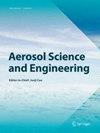Bacterial Bioaerosol at Sewage Treatment Plant in Delhi, India: Characterization and Site-Specific Associations
Abstract
Microbiological air sampling using a six-stage cascade impactor and subsequent analysis of viable mesophilic Gram- positive and Gram-negative bioaerosols at different steps of a sewage treatment plant (STP) in Delhi revealed very high spatial variations in bacteria among bio-aerosols in numbers and species. The bioaerosol concentration of Gram-positive bacteria ranged from 12 ± 07 to 997 ± 178 CFU m− 3 at different sites of STP with peak values in post-monsoon at the aeration tank (997 ± 178 CFU m− 3) and lowest values in winter at the final settlement tank (FST). The minimum concentration of Gram-negative bacteria was 35 ± 12 CFU m− 3 at inlet 1 during the winter season and maximum with 749 ± 126 CFU m− 3 at the aeration tank during the post-monsoon season. These numbers by far exceeds similar observations mentioned by various EPA’s literature both in terms of concentrations and seasonal variability in an outdoor environment. Univariate ANOVA analysis showed that sampling vs. seasons and sampler stages had the highest individual effect (p = 0.000) and no significant interactive effect (p = 0.611) of seasons and stages on Gram- positive bacterial bioaerosol concentration at inlet 1. The activated sludge treatment facility was the site where highest individual (p = 0.000) and interactive effect (p = 0.000) were found for Gram- negative bacterial bioaerosol. The significant higher regression coefficient (R2) values for Gram- positive and Gram- negative bacteria were observed to be 0.866 and 0.915 respectively in the pre-monsoon season between fine and coarse fractions of aerosols. The maximum concentrations for both types of bacteria were found in the respirable size fraction of particles which are less than 4.7 μm in aerodynamic diameter.

 求助内容:
求助内容: 应助结果提醒方式:
应助结果提醒方式:


